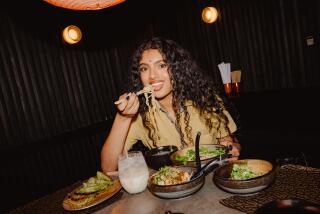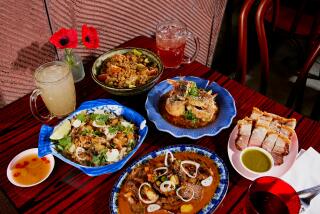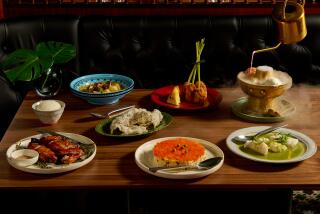From Turnip to Tour de Force
Diana Calbo scraped the turnip into a smooth white globe, then coaxed one long, spidery petal after another with flicks of her knife.
Voraluksana Aksagul held a watermelon firmly in place with one hand, and with the other gouged wave after wave of pink-and-green ribbon out of its crunchy flesh. Kumari Smati, meanwhile, carefully raised tiny feathers on the skin of a yellow squash.
Soon, a chrysanthemum, a blooming rose and a graceful bird appeared on the table that minutes earlier had been spread with ordinary produce.
The women are practicing the formal art of Thai fruit and vegetable carving. Each Sunday, they and about 20 other students crowd into a classroom at the Wat Thai Temple in North Hollywood, where they learn techniques developed hundreds of years ago.
It is feather by feather, petal by petal and scale by scale that the fruits and vegetables begin their transformation, often with breathtaking results.
The yellow squash takes wing as a delicately feathered bird. A yam wriggles to life in the shape of a goldfish. A stodgy rutabaga blossoms into an orchid, and an ordinary carrot becomes an ornate candlestick.
“This is a unique Thai art,” says instructor Sophie Albright. “You can find carving in all nations, but if you take a close look, Thai carving is very elaborate.”
The art form was originally practiced in the kitchens of the Thai royal court and those of ranking Thai families. Rather than simply slicing the fruits and vegetables of the privileged, cooks carved them into edible masterpieces.
“The Thai people wanted to do something more interesting and beautiful,” says Vibul Wonprasat, director of the Thai Community Arts and Cultural Center in Marina del Rey.
Eventually, carving spread throughout the country as a coveted cultural skill and today it is taught to all grade-school students there, Albright says. Locally, carving classes are offered at the temple in North Hollywood and are occasionally taught at community colleges.
“The carvings are a beautiful sign of peacefulness,” says Albright, a resident of Simi Valley who has been a carving instructor at the temple for about seven years.
Although there is no religious significance to the carvings, Wonprasat says those who possess the skill sometimes carve fruits and vegetables as a special offering to Buddhist monks. The carvings are also served to special guests.
Passed from generation to generation, the art form arrived in North Hollywood in the mid-1950s when a pair of Thai women, both recent emigres, began offering carving lessons from a small home, Albright says. The women continued teaching the class until the 1980s, when one died and the other returned to Thailand.
It was at that point that Albright, who had studied with them for about three years, took over as an instructor. She and Oranuch Lathitham, Pratin Santi and Nitaya Prasertpakdikul take turns teaching basic and advanced courses at the temple.
On Sundays, students--men and women, children and adults--arrive at 11 a.m. armed with fruits and vegetables for the week’s assignment. Seating themselves around two long tables covered with Thai newspapers, they set to work.
It is here at the tables--one reserved for basic students, the other for advanced--that skills are acquired, friendships are formed and a culture is preserved.
Diana Calbo, a 16-year-old high school student whose mother is from Thailand, says she enrolled because she wanted to learn a Thai tradition.
Vera Konkankit, a rambunctious 11-year-old, says her mother signed her up for the class in the hope that she will learn grace and patience. Mary Panaguiton says learning to carve has helped her reap a new sense of enjoyment from life.
“Carving is my therapy,” says Panaguiton, of Van Nuys. “It’s a sunshine in my darkened soul.”
Panaguiton, a Filipina, says she was first exposed to the art form at a Thai restaurant. An employee referred her to the classes at the Wat Thai Temple, where she has been perfecting her technique for a year.
“It’s not hard if you have the patience of a saint,” she says.
After learning how to manipulate their knives and tools, the students learn increasingly advanced carving techniques as they work their way through a list of assignments, beginning with dahlias and rose buds carved from turnips and progressing to elaborate containers finessed from squashes.
The classes are free, though the temple requests a $100 donation from each student to help cover overhead. The students also pay about $30 each for their tools, which are imported from Thailand.
The only other expense is the produce. The most common vegetables used are turnips, beets, rutabagas, carrots, chayotes and a variety of squashes, Albright says.
While students are allowed to invent designs, Albright says she always teaches classic Thai design to show how it differs from food carvings from other nations such as Japan or China.
“If you understand the concept we give in the class and follow it closely, it’s not difficult,” she says.
In Thailand as well as in the United States, the carvings are used as food decorations in major hotels. Some of Albright’s students have taken her classes to help them secure food service jobs.
The ability to transform a homely turnip into a delicate garnish is a talent that has begun to interest a growing number of people from outside the Thai community, says Pat Tseng, who also carves at the North Hollywood temple.
“There are a lot of people who are very interested in learning fruit and vegetable carving because it’s so artistic, interesting and amazing,” Tseng says.


